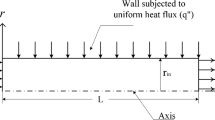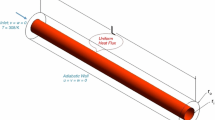Abstract
Heat flux enhancement resulting from utilization of variant graphene-based nanoparticles; graphenes, graphene nanoplatelets, graphene oxides (GOs), carbon nanotubes (CNTs which include single and multiple walled CNTs) in a water-base fluid is focussed in the present study. A steady, laminar, incompressible, mixed convective and reversed stagnation point flow together with the consideration of transverse magnetic field over varying angles of an inclined permeable cylinder is analyzed for the heterogeneous nanofluids. The governing partial differential equations based on Tiwari-Das model are reformulated into nonlinear ordinary differential equations by applying similarity expressions. A shooting procedure is opted to reformulate the equations into boundary value problems which are solved by employing a numerical finite difference code utilizing three-stage Lobatto IIIa formula in MATLAB. The effects of constructive parameters toward the model on non-dimensional velocity and temperature disseminations, reduced skin friction coefficient and reduced Nusselt number are graphically reported and discussed in details. It is observed that GOs-water has the lowest heat flux performance under increasing values of wall permeability parameter, curvature parameter and nanoparticle volume fraction as compared to other nanofluids. On contrary, our results demonstrate that graphenes-water has the highest heat flux performance as compared to SWCNTs-water across many emerging parameters considered in this study.








Similar content being viewed by others
References
Choi SU, Eastman JA (1995) Enhancing thermal conductivity of fluids with nanoparticles, International mechanical engineering congress and exhibition, San Francisco, CA (United States), 12–17 Nov 1995.https://www.osti.gov/servlets/purl/196525/
Haq RU, Nadeem S, Khan ZH, Noor NFM (2015) MHD squeezed flow of water functionalized metallic nanoparticles over a sensor surface. Phys E 73:45–53
Pandey AK, Rajput S, Bhattacharyya K, Sibanda P (2021) Impact of metal oxide nanoparticles on unsteady stagnation point flow of the hybrid base fluid along a flat surface. Pramana 95:1–9
Sheikholeslami M, Rashidi MM, Ganji DD (2015) Effect of non-uniform magnetic field on forced convection heat transfer of Fe3O4-water nanofluid. Comput Methods Appl Mech Eng 294:299–312
Verma AK, Gautam AK, Bhattacharyya K, Sharma RP (2021) Existence of boundary layer nanofluid flow through a divergent channel in porous medium with mass suction/injection. Sadhana 46:1–10
Hayat T, Hussain Z, Muhammad T, Alsaedi A (2016) Effects of homogeneous and heterogeneous reactions in flow of nanofluids over a nonlinear stretching surface with variable surface thickness. J Mol Liq 221:1121–1127
Bhattacharyya K, Layek GC (2011) Effects of suction/blowing on steady boundary layer stagnation-point flow and heat transfer towards a shrinking sheet with thermal radiation. Int J Heat Mass Transf 54:302–307
Seth GS, Singha AK, Mandal MS, Banerjee A, Bhattacharyya K (2017) MHD stagnation-point flow and heat transfer past a non-isothermal shrinking/stretching sheet in porous medium with heat sink or source effect. Int J Mech Sci 134:98–111
Kumar PM, Kumar CA (2019) Numerical evaluation of cooling performances of semiconductor using CuO/water nanofluids. Heliyon. https://doi.org/10.1016/j.heliyon.2019.e02227
Bhattacharyya K, Mukhopadhyay S, Layek GC (2011) Slip effects on boundary layer stagnation-point flow and heat transfer towards a shrinking sheet. Int J Heat Mass Transf 54:308–313
Selimefendigil F, Öztop HF (2019) MHD mixed convection of nanofluid in a flexible walled inclined lid-driven L-shaped cavity under the effect of internal heat generation. Statist Mech Appl, Phys A, p 122144. https://doi.org/10.1016/j.physa.2019.122144
Dinarvand S, Hosseini R, Pop I (2017) Axisymmetric mixed convective stagnation-point flow of a nanofluid over a vertical permeable cylinder by Tiwari-Das nanofluid model. Powder Technol 311:147–156
Gholinia M, Gholinia S, Hosseinzadeh K, Ganji DD (2018) Investigation on ethylene glycol nano fluid flow over a vertical permeable circular cylinder under effect of magnetic field. Results Phys 9:1525–1533
Reddy SRR, Reddy PBA, Bhattacharyya K (2019) Effect of nonlinear thermal radiation on 3D magneto slip flow of Eyring-Powell nanofluid flow over a slendering sheet with binary chemical reaction and Arrhenius activation energy. Adv Powder Technol 30:3203–3213
Ashorynejad HR, Zarghami A (2018) Magnetohydrodynamics flow and heat transfer of Cu-water nanofluid through a partially porous wavy channel. Int J Heat Mass Transf 119:247–258
Purbia D, Khandelwal A, Kumar A, Sharma AK (2019) Graphene-water nanofluid in heat exchanger: mathematical modelling, simulation and economic evaluation. Int Commun Heat Mass Transf. https://doi.org/10.1016/j.icheatmasstransfer.2019.104327
Sheikholeslami M, Shamlooei M, Moradi RJCE (2018) Numerical simulation for heat transfer intensification of nanofluid in a porous curved enclosure considering shape effect of Fe3O4 nanoparticles. Chem Eng Process-Process Intensif 124:71–82
Haq RU, Nadeem S, Khan ZH, Noor NFM (2015) Convective heat transfer in MHD slip flow over a stretching surface in the presence of carbon nanotubes. Phys B 457:40–47
Kumar V, Tiwari AK, Ghosh SK (2015) Application of nanofluids in plate heat exchanger: a review. Energy Convers Manage 105:1017–1036
Sadeghinezhad E, Mehrali M, Saidur R, Mehrali M, Latibari ST, Akhiani AR, Metselaar HSC (2016) A comprehensive review on graphene nanofluids: recent research, development and applications. Energy Convers Manage 111:466–487
Ghozatloo A, Rashidi A, Shariaty-Niassar M (2014) Convective heat transfer enhancement of graphene nanofluids in shell and tube heat exchanger. Exp Thermal Fluid Sci 53:136–141
Tiwari RK, Das MK (2007) Heat transfer augmentation in a two-sided lid-driven differentially heated square cavity utilizing nanofluids. Int J Heat Mass Transf 50(9–10):2002–2018
Oztop HF, Abu-Nada E (2008) Numerical study of natural convection in partially heated rectangular enclosures filled with nanofluids. Int J Heat Fluid Flow 29(5):1326–1336
Muhammad S, Ali G, Shah Z, Islam S, Hussain S (2018) The rotating flow of magneto hydrodynamic carbon nanotubes over a stretching sheet with the impact of non-linear thermal radiation and heat generation/absorption. Appl Sci. https://doi.org/10.3390/app8040482
Sandeep N, Malvandi A (2016) Enhanced heat transfer in liquid thin film flow of non-Newtonian nanofluids embedded with graphene nanoparticles. Adv Powder Technol 27(6):2448–2456
Upadhya SM, Raju CSK, Saleem S, Alderremy AA (2018) Modified Fourier heat flux on MHD flow over stretched cylinder filled with dust, graphene and silver nanoparticles. Results Phys 9:1377–1385
Javanmard M, Taheri MH, Abbasi M, Ebrahimi SM (2018) Heat transfer analysis of hydromagnetic water-graphene oxide nanofluid flow in the channel with asymmetric forced convection on walls. Chem Eng Res Des 136:816–824
Azimi M, Azimi A, Mirzaei M (2014) Investigation of the unsteady graphene oxide nanofluid flow between two moving plates. J Comput Theor Nanosci 11(10):2104–2108
Amin M, Putra N, Kosasih EA, Prawiro E, Luanto RA, Mahlia TMI (2017) Thermal properties of beeswax/graphene phase change material as energy storage for building applications. Appl Therm Eng 112:273–280
Acknowledgements
Contribution of anonymous reviewer/s toward improvement of this work is highly appreciated. The first and the corresponding authors received financial support under the Project RF013B-2018 of Faculty of Science-Universiti Malaya Research Grant (FS-UMRG). We further declare that there is no conflict of interest among the authors on submission and publication process of this manuscript.
Author information
Authors and Affiliations
Corresponding author
Additional information
Publisher's Note
Springer Nature remains neutral with regard to jurisdictional claims in published maps and institutional affiliations.
Rights and permissions
About this article
Cite this article
Ghani, S.N.A., Yarmand, H. & Noor, N.F.M. Assorted Graphene-Based Nanofluid Flows Near a Reversed Stagnation Point over an Inclined Permeable Cylinder. Proc. Natl. Acad. Sci., India, Sect. A Phys. Sci. 93, 43–55 (2023). https://doi.org/10.1007/s40010-022-00782-z
Received:
Revised:
Accepted:
Published:
Issue Date:
DOI: https://doi.org/10.1007/s40010-022-00782-z




